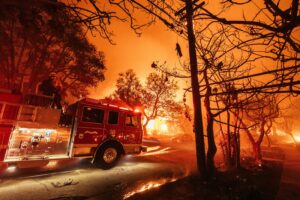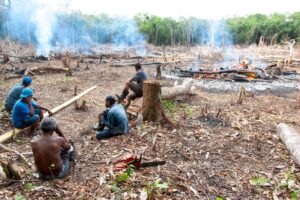I don’t know about you, but since work from home started in earnest, meetings seem full of check-in questions. Don’t get me wrong, I like them. One of my favorites that comes up regularly is, who was your favorite teacher? Answers always feature people whose love and passion for their area of expertise shine through in their teaching.
Working with Marie Fargo, our Instructional Resources Coordinator, to plan a new K-2 climate change resource, I was reminded of this phenomenon. As we brainstormed ideas that connect climate change to K-2 standards, I found myself filled with memories of warm summer days in my Grandma’s flower garden, watching the hens and chicks spreading out into the pebble-covered path and the sounds of my grandfather and uncles lamenting the weather and attempting to plan that year’s corn crop. These fond memories made me focus on topics like crop production and farming, pollination, and climate change. Unsurprisingly, I prefer to focus on these topics; they make me feel warm and nostalgic, are central to my being, and are impacted by climate change.
Teachers’ best work happens when their personal interests and professional expertise align and they have the resources and support to put theory into practice.
- You need support on how to teach climate change:
Educators tend to shine when they teach about things they love and when they have support. It’s no wonder that many teachers only spend 1-2 hours a year on climate change — a subject that has and continues to be dominated by narratives of loss, sadness, guilt and culpability. Further limiting teacher’s interest in teaching climate change are the flurry of politically charged narratives and perceived lack of support for teaching the topic in anything that isn’t science.
I applaud and marvel at the teachers who have been teaching climate change for decades. We see you. However, most teachers find themselves among the majority of Americans who believe in climate change and think it should be taught in school but just aren’t sure how or where to start. This gap isn’t a result of the teachers not doing the work. It’s more systemic than that. The systems teachers use to learn about key subjects and ways to incorporate those topics into their practice are lagging behind.
- You need access to quality teaching materials that center local climate change challenges and solutions:
To teach climate change effectively, teachers need access to quality, local teaching materials, time to adapt and implement them, and ongoing support to continue the work.
Several polls have shown that educators don’t teach about climate change because they feel uninformed about it or that the science is out of their depth. Furthermore, if educators feel under-supported by their administrators in their effort to teach climate change, they are far less likely to do so.
There are many states and school districts addressing teachers’ concerns and filling needs with innovative and scalable models of climate change education. The Wisconsin Climate Education Hub was created to provide educators with quick, easy access to high-quality instructional resources to support the state’s requirement for environmental education. They are now working with Wisconsin educators to create new instructional materials centering Wisconsin-based issues and solutions. An example closer to Climate Generation’s home is in Saint Paul Public Schools (SPPS). The facilities team leads the SPPS Sustainability Program, which provides teaching materials to educators, guidance on how to jump in to support their district’s climate action plan, and supports students to lead action projects at their schools.
- You need ongoing training:
Not knowing where to get support or what materials to use to incorporate climate curriculum into your plan can be exhausting. On top of that, it can be tiring to not be connected to a community of other educators and mentors going through the same challenges you are.
Each year, Climate Generation hosts our Summer Institute for Climate Change Education – registration for our 19th year has just opened! At the Summer Institute, educators connect to a vast network of climate change professionals. They are inspired to learn new connections to the subjects they teach and to fill their virtual tote bags with instructional materials and curriculum. Professional development events, like a Summer Institute, reinvigorate educators, but they don’t solve some of the major challenges they face trying to transform their teaching practice.
Teachers need that reinvigorating spark from an event, and they also need sustained support for the long-lasting passion. It’s well known that people remain excited for about 2 weeks after a professional development event. Rather than one-off events for support, teachers require a mixed bag of options that extend throughout the year. Educators who engage in 50 or more hours of professional development from workshops, online communities, personal research, instructional coaching, and peer-to-peer working groups are far more likely to change their practice and find the support they need to sustain the change.
This is why Climate Generation offers the Teach Climate Network and regional education support. The Teach Climate Network provides year-round professional development opportunities for K-12 and nonformal educators through: monthly webinars, regular working groups, and a monthly e-newsletter with tips and tricks on teaching climate change. Our regional education work supports educators through facilitated curriculum coaching, communities of practice, and paid working groups. This year, in collaboration with our Talk Climate Program, we also offered a unique Inspiring Stories project to help educators find their personal connection to climate change.
To ignite change in how we teach about climate change, we need to help educators find their passion for climate change education. We must replace the overly simplistic narratives we’ve become accustomed to with stories of love, compassion, enthusiasm, and strength.
Teaching about climate change and moving people to take action on climate change doesn’t require a deep understanding of the greenhouse effect. To those of us teaching climate change day in and day out, we’ve learned that climate change resilience and adaptability, or the ability to bounce back from climate change impacts, is what communities need to understand and respond to the climate crises they are facing now.
There are many ways to teach about climate change that uplift the people power behind climate change solutions and center a just transition to a brighter, safer, and more equitable future. We suggest teaching activities that engage people on a personal level, weave in some hands-on exploration of climate change facts, and support action-based projects in their local communities. I encourage you to join our Teach Climate Network to get access to the many opportunities we offer to build your climate education practice.
Teaching about climate change and its connections back to farming makes me feelcloser to my family. You can read my climate story on Climate Generation’s Blog. I’m keeping my family traditions alive by continuing to learn how to best steward and tend the earth in an unpredictable future. Teaching others how to do so helps me build my community and welcome others into my world.

Lindsey Kirkland supports on-going climate change education programs for K-12 educators and public audiences. As the Education Manager, she also develops a vision for and provides strategic coordination for programs focusing primarily on professional development for teachers and informal educators. Lindsey is adjunct faculty at Hamline University and supported the development of their Climate Literacy Certificate, a contributing author of NSTA’s Connect Science Learning journal, and an active member of Climate Literacy and the Energy Awareness Network (CLEAN) and the North American Association of Environmental Education (NAAEE) Guidelines for Excellence writing team. Lindsey has served as an environmental educator with the AmeriCorps program the NJ Watershed Ambassadors, worked as a naturalist and education program coordinator for the NJ Audubon Society, and assisted in program development for museums, universities, and new nonprofit organizations in the United States and Australia. Lindsey holds a BS in Environment, Conservation and Fisheries Sciences from the University of Washington in Seattle, WA and a MEd in Science Education from Rutgers University in New Brunswick, NJ. In her spare time, Lindsey enjoys spending time with her husband and her son.
The post 3 reasons why you are burnt out teaching climate change, and how to sustain your spark appeared first on Climate Generation.
3 reasons why you are burnt out teaching climate change, and how to sustain your spark
Climate Change
UN report: Five charts showing how global deforestation is declining
The amount of forest lost around the world has reduced by millions of hectares each year in recent decades, but countries are still off track to meet “important” deforestation targets.
These are the findings of the Global Forest Resources Assessment – a major new report from the UN’s Food and Agriculture Organization – which says that an estimated 10.9m hectares (Mha) of land was deforested each year between 2015 and 2025.
This is almost 7Mha less than the amount of annual forest loss over 1990-2000.
Since 1990, the area of forest destroyed each year has halved in South America, although it still remains the region with the highest amount of deforestation.
Europe was the only region in the world where annual forest loss has increased since 1990.
Agriculture has historically been the leading cause of deforestation around the world, but the report notes that wildfires, climate change-fuelled extreme weather, insects and diseases increasingly pose a threat.
The Global Forest Resources Assessment is published every five years. The 2025 report compiles and analyses national forest data from almost every country in the world over 1990-2025.
Carbon Brief has picked out five key findings from the report around deforestation, carbon storage and the amount of forest held within protected areas around the world.
1. Rates of deforestation are declining around the world
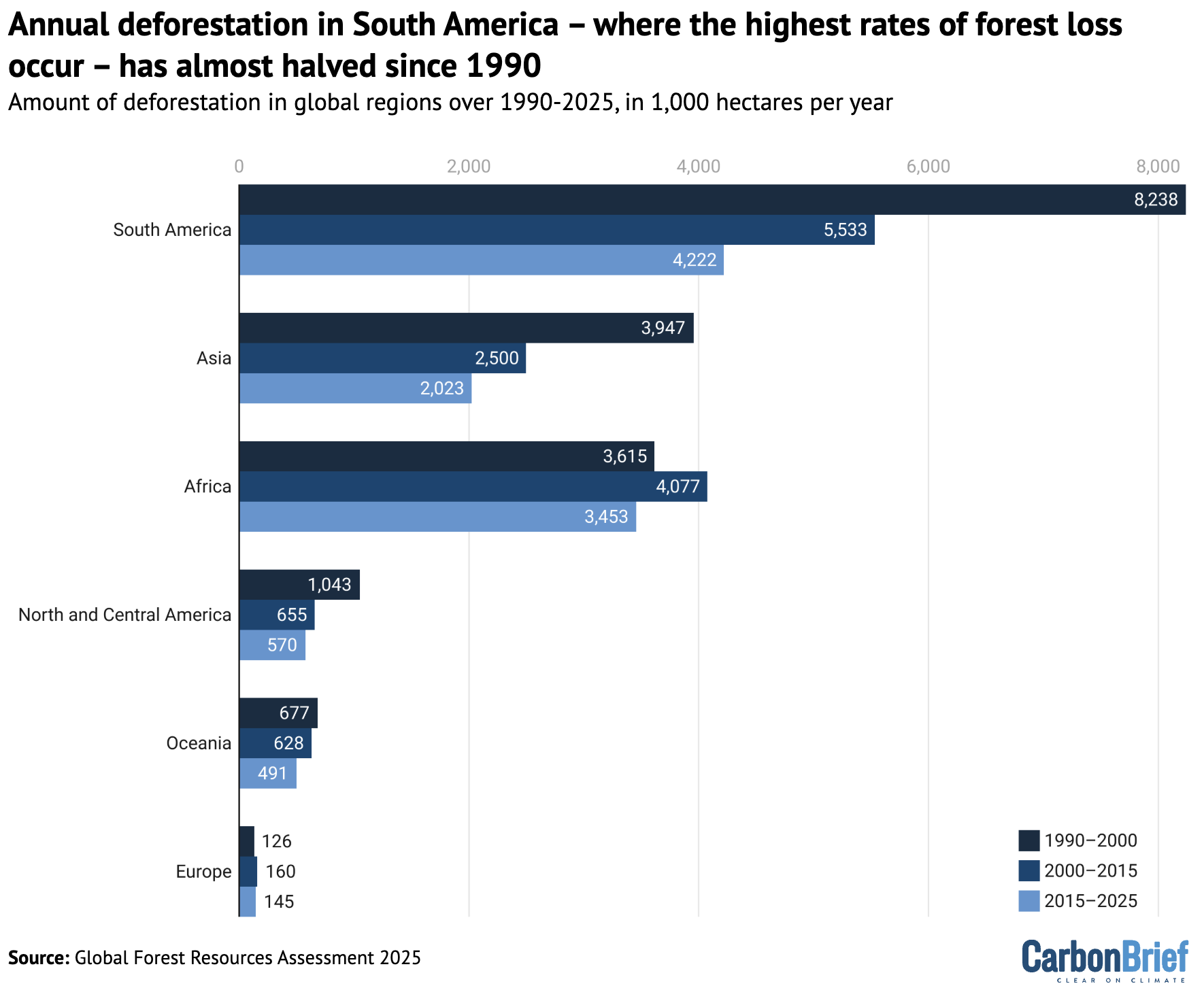
Rates of annual deforestation, in thousands of hectares, in South America, Asia, Africa, North and Central America, Oceania and Europe over 1990-2000 (dark blue), 2000-15 (medium blue) and 2015-25 (light blue). Source: Global Forest Resources Assessment 2025
In total, around 489Mha of forest have been lost due to deforestation since 1990, the new report finds. Most of this – 88% – occurred in the tropics.
This breaks down to around 10.9Mha of forest lost each year between 2015 and 2025, a reduction compared to 13.6Mha of loss over 2000-15 and 17.6Mha over 1990-2000.
Deforestation refers to the clearing of a forest, typically to repurpose the land for agriculture or use the trees for wood.
The chart above shows that South America experiences the most forest loss each year, although annual deforestation levels have halved from 8.2Mha over 1990-2000 to 4.2Mha over 2015-25.
Annual deforestation in Asia also saw a sizable reduction, from 3.9Mha over 1990-2000 to 2Mha over 2015-25, the report says.
Europe had the lowest overall deforestation rates, but was also the only region to record an increase over the last 35 years, with deforestation rates growing from 126,000 hectares over 1990-2000 to 145,000 hectares in the past 10 years.
Despite the downward global trend, FAO chief Dr Qu Dongyu notes in the report’s foreword that the “world is not on track to meet important global forest targets”.
In 2021, more than 100 countries pledged to halt and reverse global deforestation by 2030. But deforestation rates in 2024 were 63% higher than the trajectory needed to meet this 2030 target, according to a recent report from civil society groups.
The goals of this pledge were formally recognised in a key text at the COP28 climate summit in Dubai in 2023, which “emphasise[d]” that halting and reversing deforestation and forest degradation by 2030 would be key to meeting climate goals.
2. Global net forest loss has more than halved since 1990
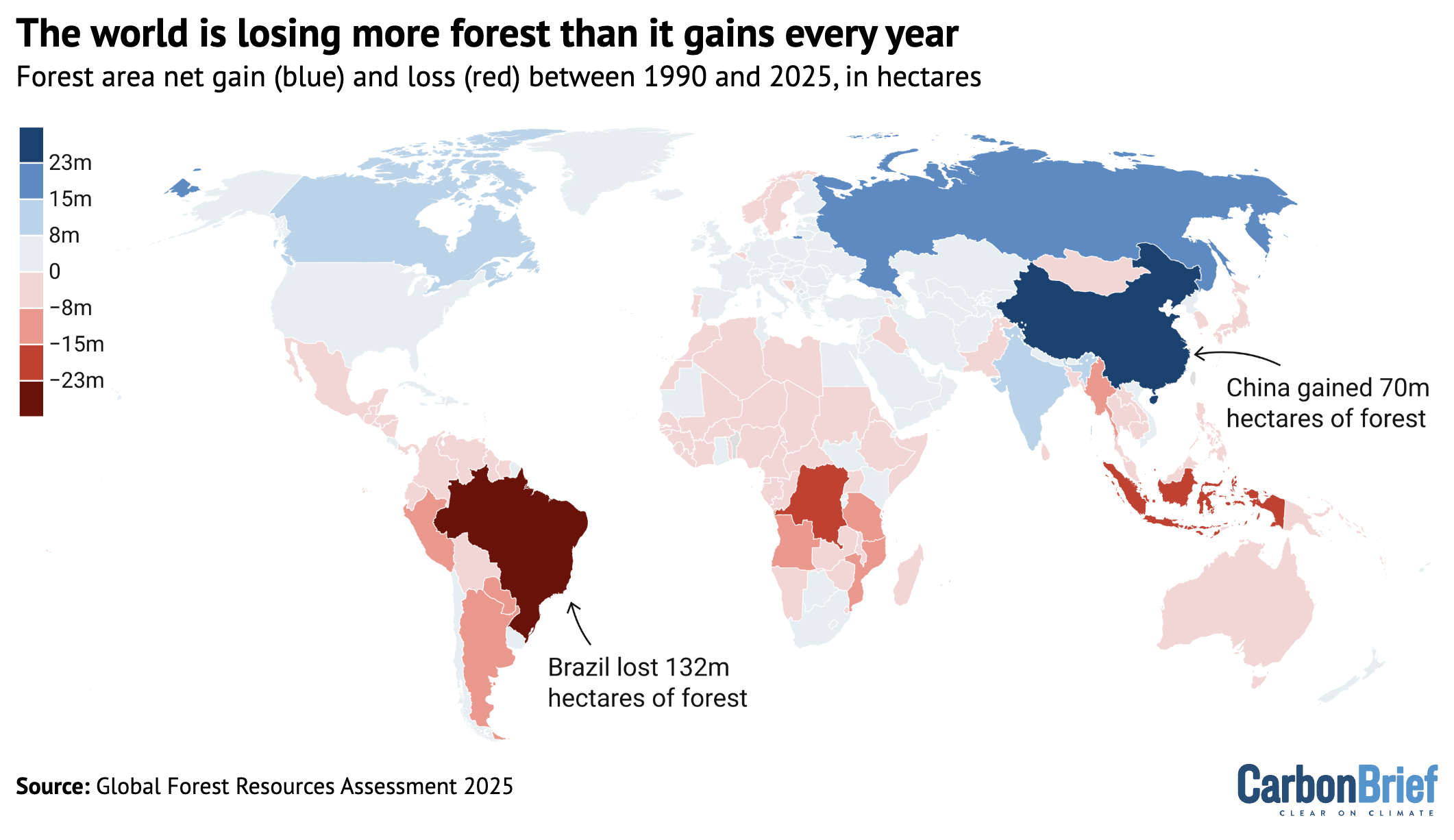
Forest area net change by country between 1990 and 2025, in hectares. Source: Global Forest Resources Assessment 2025
The new report finds that forests cover more than 4bn hectares of land, an area encompassing one-third of the planet’s land surface.
More than half of the world’s forested area is located in just five countries: Russia, Brazil, Canada, the US and China.
The map above shows that, overall, more forest is lost than gained each year around the world. There was 6.8Mha of forest growth over 2015-25, but 10.9Mha of forest lost.
The annual rate of this global net forest loss – the amount that deforestation has exceeded the amount regrown – has more than halved since 1990, dropping from 10.7Mha over 1990-2000 to 4.1Mha over 2015-25.
The report says this change was due to reduced deforestation in some countries and increased forest expansion in others. However, the rate of forest expansion has also slowed over time – from 9.9Mha per year in 2000-15 to 6.8Mha per year in 2015-25.
There are many driving factors behind continuing deforestation. Agriculture has historically been the leading cause of forest loss, but wildfire is increasingly posing a threat. Wildfires were the leading driver of tropical forest loss in 2024 for the first time on record, a Global Forest Watch report found earlier this year.
The new UN report says that an average of 261Mha of land was burned by fire each year over 2007-19. Around half of this area was forest. Around 80% of the forested land impacted by fires in 2019 was in the subtropics – areas located just outside tropical regions, such as parts of Argentina, the US and Australia.
The report notes that fire is widely used in land management practices, but uncontrolled fires can have “major negative impacts on people, ecosystems and climate”.
It adds that researchers gathered information on fires up as far as 2023, but chose to focus on 2007-19 due to a lack of more recent data for some countries.
A different report from an international team of scientists recently found that fires burned at least 370Mha of land – an area larger than India – between March 2024 and February 2025.
3. Many countries are hugely increasing their forest area
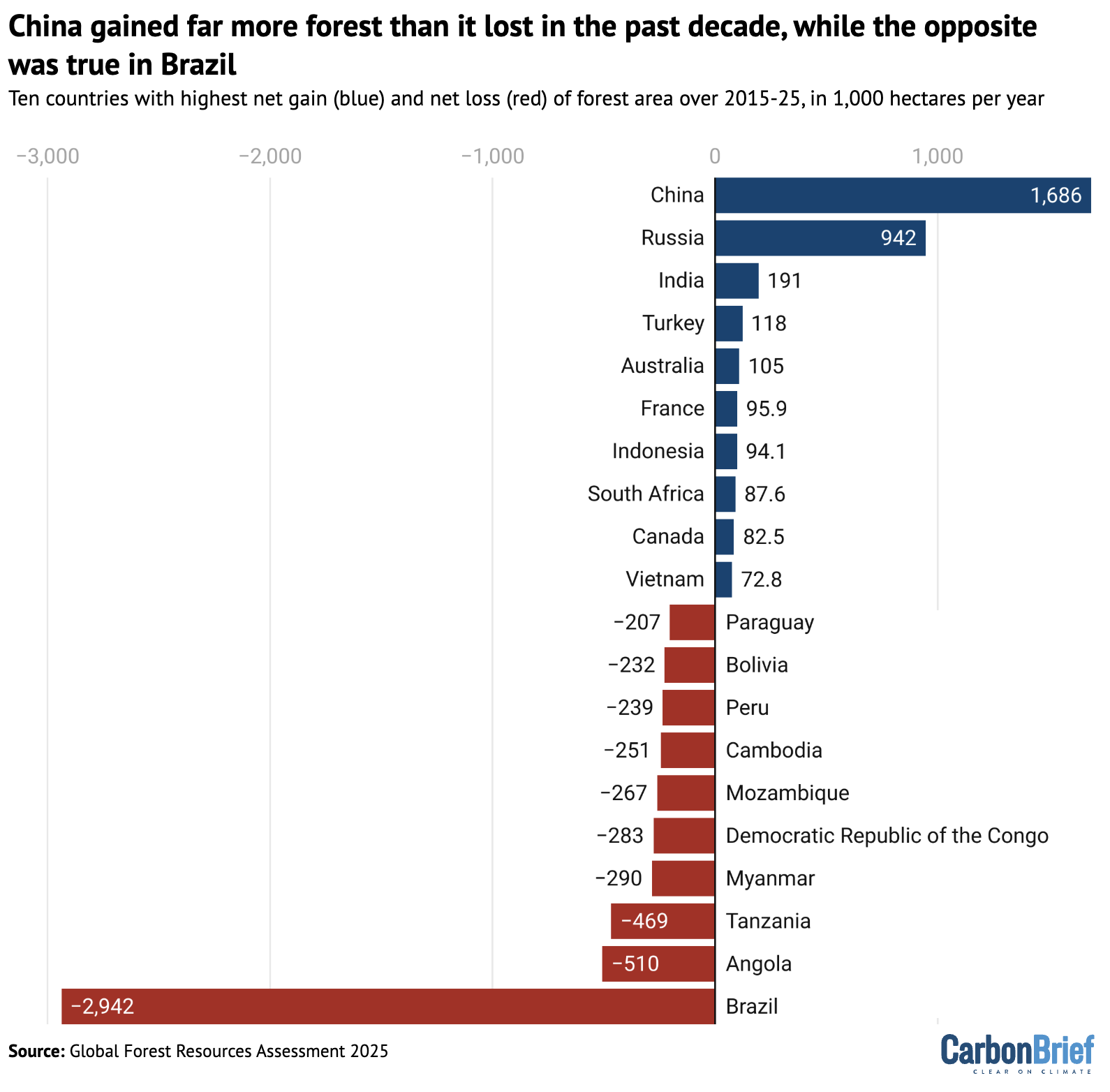
Top 10 countries for annual net gain (blue) and net loss (red) of forest area over 2015-25, in 1,000 hectares per year. Source: Global Forest Resources Assessment 2025
Globally, deforestation is declining, but the trend varies from country to country.
The chart above shows that some nations, such as China and Russia, added a lot more forest cover than they removed in the past decade through, for example, afforestation programmes.
But in other countries – particularly Brazil – the level of deforestation far surpasses the amount of forest re-grown.
Deforestation in Brazil dropped by almost one-third between 2023 and 2024, news outlet Brasil de Fato reported earlier this year, which was during the time Luiz Inácio Lula da Silva took over as president. The new UN report finds that, on average, Brazil lost 2.9Mha of forest area each year over 2015-25, compared to 5.8Mha over 1990-2000.
Russia’s net gain of forest cover increased significantly since 1990 – growing from 80,400ha per year in 1990-2000 to 942,000ha per year in 2015-25.
In China, although it is also planting significant levels of forest, the forest level gained has dropped over time, from 2.2Mha per year in 2000-15 to 1.7Mha per year in 2015-25.
Levels of net forest gain in Canada also fell from 513,000ha per year in 2000-15 to 82,500ha per year in 2015-25.
In the US, the net forest growth trend reversed over the past decade – from 437,000ha per year of gain in 2000-15 to a net forest loss of 120,000ha per year from 2015 to 2025.
Oceania reversed a previously negative trend to gain 140,000ha of forests per year in the past decade, the report says. This was mainly due to changes in Australia, where previous losses of tens of thousands of hectares each year turned into an annual net gain of 105,000ha each year by 2015-25.
4. The world’s forests hold more than 700bn tonnes of carbon
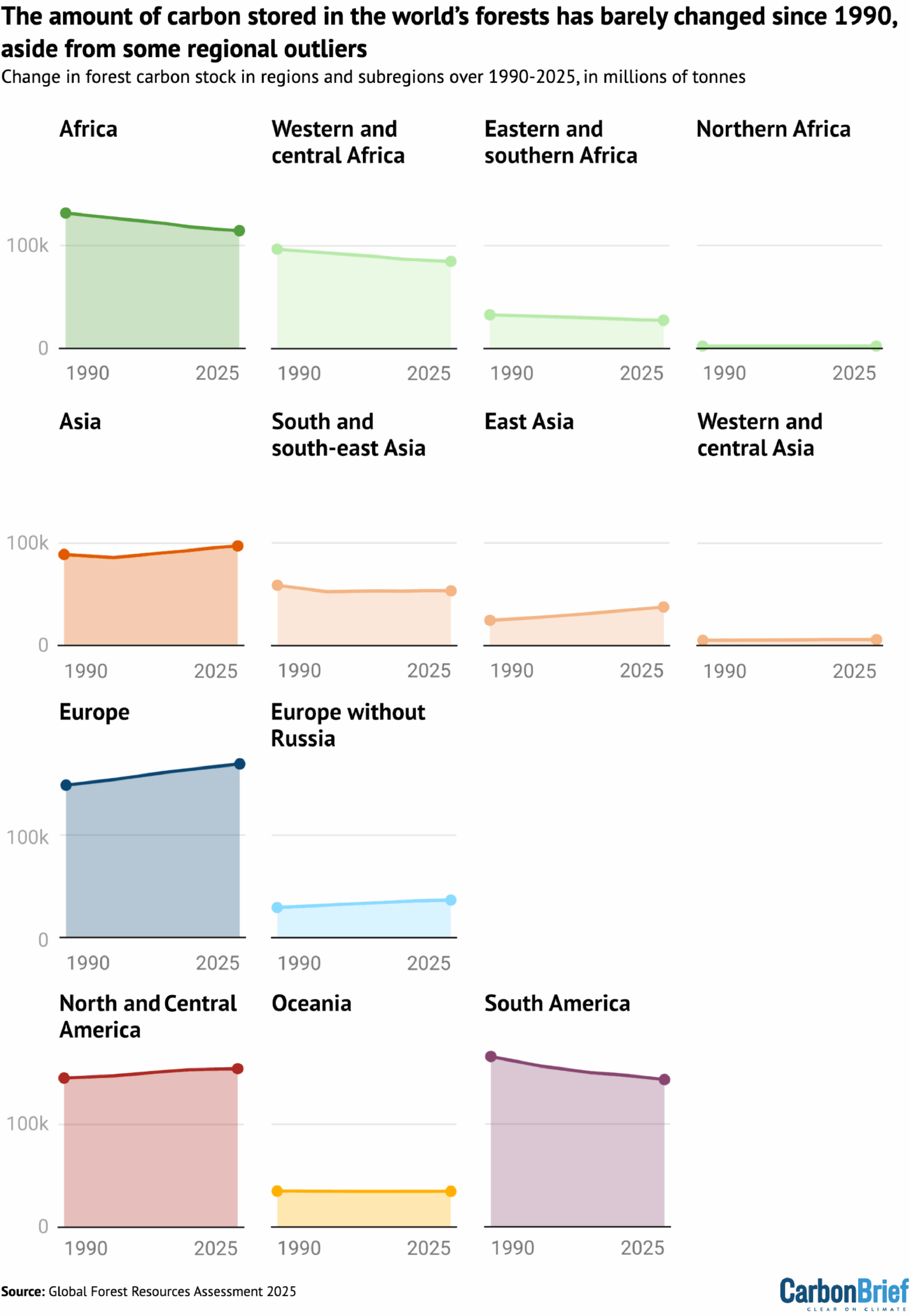
Changes in forest carbon stock by region and subregion of the world over 1990-2025. Source: Global Forest Resources Assessment 2025
The “carbon stock” of a forest refers to how much carbon is stored in its trees and soils. Forests are among the planet’s major carbon sinks.
The new report estimates that forests stored an estimated 714bn tonnes, or gigatonnes, of carbon (GtC) in 2025.
Europe (including Russia) and the Americas account for two-thirds of the world’s total forest carbon storage.
The global forest carbon stock decreased from 716GtC to 706GtC between 1990 and 2000, before growing slightly again by 2025. The report mainly attributes this recent increase to forest growth in Asia and Europe.
The report notes that the total amount of carbon stored in forests has remained largely static over the past 35 years, but with some regional differences, as highlighted in the chart above.
The amount of carbon stored in forests across east Asia, Europe and North America is “significantly higher” now due to expanded forest areas, but it is lower in South America, Africa and Central America.
Several studies have shown that there are limitations on the ability of forests to keep absorbing CO2, with difficulties posed by hotter, drier weather fuelled by climate change.
A 2024 study found that record heat in 2023 negatively impacted the ability of land and ocean sinks to absorb carbon – and that the global land sink was at its weakest since 2003.
Another study, published in 2022, said that drying and warming as a result of deforestation reduces the carbon storage ability of tropical forests, especially in the Congo basin and the Amazon rainforest.
5. Around one-fifth of the world’s forests are located in protected areas
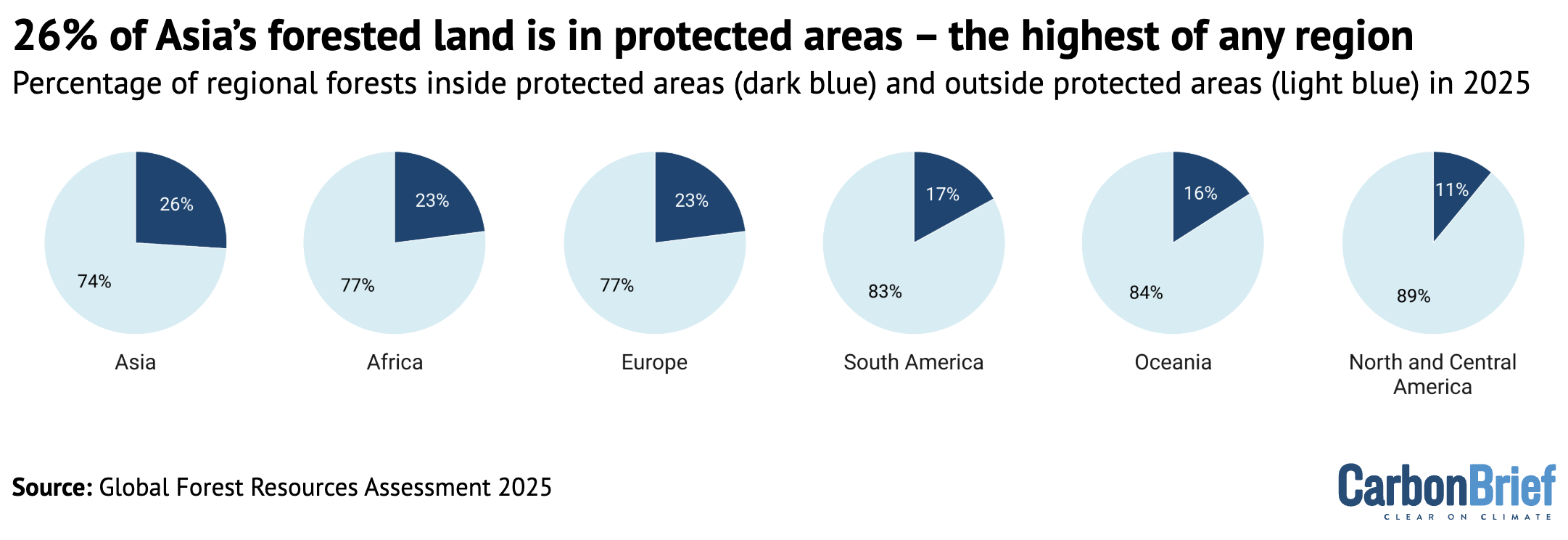
The percentage of forest land in Asia, Africa, Europe, South America, Oceania and North and Central America contained inside protected areas (dark blue) and outside protected areas (light blue) in 2025. Source: Global Forest Resources Assessment 2025
The amount of forested land located in protected areas increased across all regions between 1990 and 2025.
For an area to be considered “protected”, it must be managed in a way that conserves nature.
Around 20% of the world’s forests are located in these protected areas, the new report finds, which amounts to 813Mha of land – an area almost the size of Brazil.
Nearly every country in the world has pledged to protect 30% of the Earth’s land and sea by 2030. However, more than half of countries have not committed to this target on a national basis, Carbon Brief analysis showed earlier this year.
Almost 18% of land and around 8% of the ocean are currently in protected areas, a UN report found last year. The level is increasing, the report said, but considerable progress is still needed to reach the 2030 goal.
The new UN report notes that Europe, including Russia, holds 235Mha of protected forest area, which is the largest of any region and accounts for 23% of the continent’s total forested land.
As highlighted in the chart above, 26% of all forests in Asia are protected, which is the highest of any region. The report notes that this is largely due to a vast amount of protected forested land in Indonesia.
Three countries and one island territory reported that upwards of 90% of their forests are protected – Norfolk Island, Saudi Arabia, Cook Islands and Uzbekistan.
The post UN report: Five charts showing how global deforestation is declining appeared first on Carbon Brief.
UN report: Five charts showing how global deforestation is declining
Climate Change
Federal Appeals Court Pauses Litigation Over Florida’s Alligator Alcatraz
The Trump administration had sought the stay of proceedings in the case, arguing its attorneys were furloughed during the government shutdown. The plaintiffs say the administration is picking and choosing which cases to litigate.
A federal appeals court paused litigation Wednesday brought by environmental groups over Florida’s Alligator Alcatraz, the hastily assembled Everglades detention site where the Trump administration aims to incarcerate and deport thousands of undocumented migrants.
Federal Appeals Court Pauses Litigation Over Florida’s Alligator Alcatraz
Climate Change
Breach of Contract or Constitutional Crisis?
An appellate court will determine how to handle the Trump administration’s cancellation of hundreds of climate and environmental justice grants.
The U.S. Fourth Circuit Court of Appeals in Richmond, Virginia, heard arguments Thursday on whether the Trump administration’s cancellation of billions of dollars in environmental and climate grants earlier this year violated the Constitution or was merely a contract dispute.
-
Climate Change2 years ago
Spanish-language misinformation on renewable energy spreads online, report shows
-
Climate Change2 months ago
Guest post: Why China is still building new coal – and when it might stop
-
Climate Change Videos2 years ago
The toxic gas flares fuelling Nigeria’s climate change – BBC News
-

 Greenhouse Gases1 year ago
Greenhouse Gases1 year ago嘉宾来稿:满足中国增长的用电需求 光伏加储能“比新建煤电更实惠”
-
Greenhouse Gases2 months ago
Guest post: Why China is still building new coal – and when it might stop
-

 Climate Change1 year ago
Climate Change1 year ago嘉宾来稿:满足中国增长的用电需求 光伏加储能“比新建煤电更实惠”
-

 Carbon Footprint2 years ago
Carbon Footprint2 years agoUS SEC’s Climate Disclosure Rules Spur Renewed Interest in Carbon Credits
-
Renewable Energy3 months ago
US Grid Strain, Possible Allete Sale

